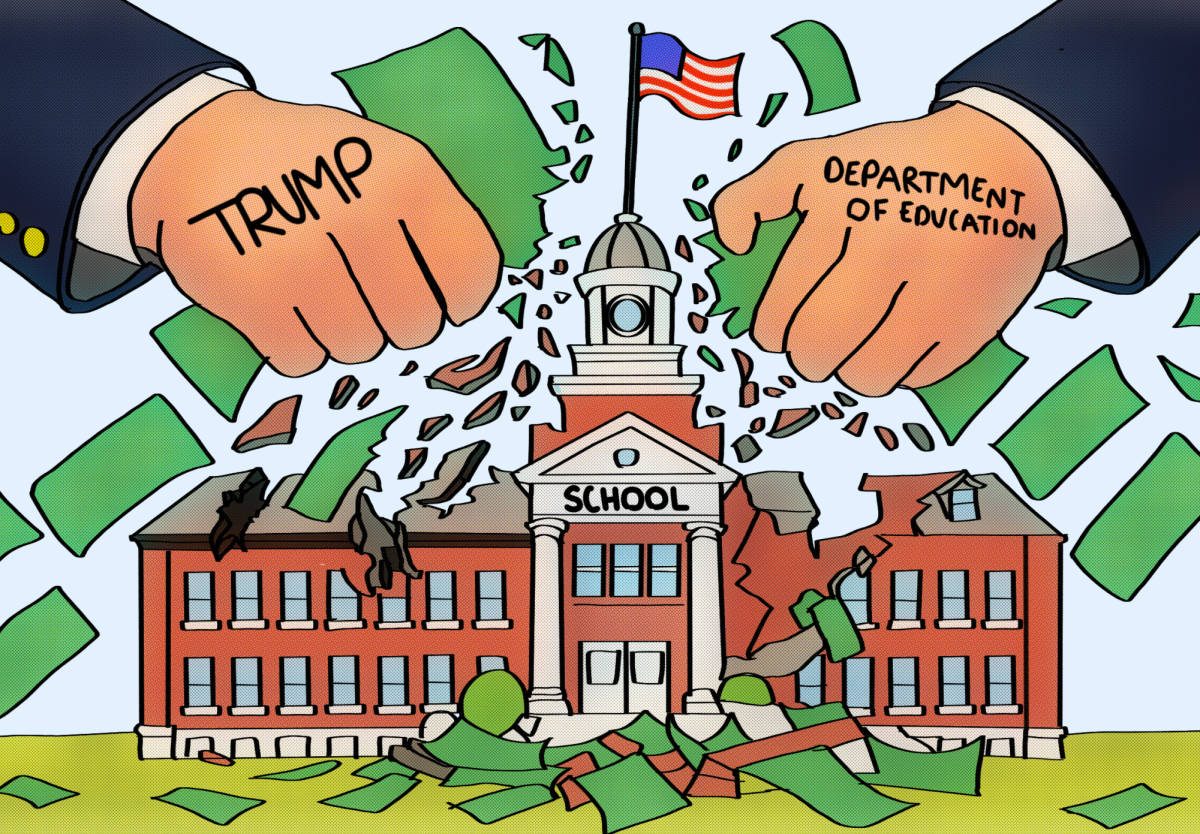When former President Jimmy Carter established the Department of Education in 1979, his goal was to place education at the forefront of national discussions, where it belonged. Yet, 45 years later, that same purpose is now becoming its demise.
This year, the election revolved around two subjects in voter’s minds: a return to life before COVID-19 and shifting power back to the states—priorities that President-elect Donald Trump leveraged to defeat Vice President Kamala Harris. However, one issue has received little attention, the future of education ahead. With Trump set to return to the White House on Jan. 20, he has vowed to dismantle the DE, reigniting a heated debate over the role of federal oversight. Suppose control of the DE is fully returned to the states. In that case, Trump risks not only disrupting nationwide regulation but also jeopardizing crucial lifelines like federal financial aid, including the Free Application for Federal Student Aid.
A Domino Effect
For decades, the DE has served as a pillar of educational progress, ensuring uniformity of equal access across all 50 states. Many receiving financial aid from programs like FAFSA have the same opportunity, especially those from low-income backgrounds, to pursue higher education and break free from generational cycles of poverty. It begs the question of what’s next if that same lifeline becomes weaker without an agency in place? Or if the person in charge of the U.S for the next four years is already taking turns stabbing the educational system in place.
To be clear, the idea of eliminating the DE is not new. In fact, political figures like President Ronald Reagan made the same case as part of his 1982 State of the Union speech before facing opposition in Congress. Yet, the idea of putting the DE on the chopping block is something not to ignore. On Nov. 21, Senator Mike Rounds introduced the “Returning Education to Our States Act,” effectively abolishing the agency and redistributing its resources for others to pick up on if passed. Pair this with Trump’s pledge, and the education of students are on the line.
As it stands, eliminating the DE and the uncertainty of a future FAFSA system in place would devastate the landscape of financial aid. Pell Grants, federal loans and work-study are all different avenues that make higher education attainable for millions of high school seniors. Still, it can all disappear in a blink of an eye with a presidential signature from Congress—one Trump is willing to provide. It is also important to mention that without a federal safety net, wealthier states may maintain some form of aid, but poorer states, particularly those in the South and Midwest, would struggle to compensate without federal involvement, leaving students in those areas with fewer options as college tuition continues to rise nationally
“The dissolution of the Department of Education and the dismantling of programs like FAFSA under the guise of austerity are expressions of a system that seeks to limit access to education to consolidate power and opportunity in the hands of the bourgeoisie,” senior Christopher Arriaza said.
In fact, precautions are already being sent out surrounding the protection of FAFSA data for undocumented and mixed-status families. While the Higher Education Act of 1965 would fill this hole, non-profit organizations such as the National College Attainment Network that serves to represent low-income, unrepresented backgrounds and first-generation students can no longer assure mixed-status students and families that data submitted to DE, as part of the FAFSA process, will continue to be protected as political leadership soon shift. It now creates a new conflict where mixed-status families are being placed in an unlikely position where they must choose between potential financial aid and their safety. It is systematically excluding some of the most vulnerable students.
In reality, what’s being put on stake is college attendees that would bear the consequences of this redirection. In a future without a system of federal aid, a promising student from a low-income household might never make it to a college campus, not because of their college application, but because of money. As best said, federal aid does not fund education, it funds dreams.
“I think it would be detrimental if the Department of Education were to close because we have a lot of people who are super smart but lack the resources to go to college because of financial reasons. As a whole of the country, we want everyone to be learning as much as they can without any barriers in place, nevertheless something controversial like ending aid. It would be hard to imagine what college application would be like without federal aid,” senior Nathalie Schwart said.
Bigger Picture
Today, the DE handles various roles including prohibiting discrimination and funding programs that help students with disabilities and low income. In addition, the DE provides billions in funding to schools, money that many states rely on for essential programs like free and reduced-price lunches, special education services and Title I funding for schools in low-income areas. Removing these funds would force states to fill the gap or leave students in poorer conditions in already underfunded public schools. This creates the point that dismantling the DE risks fragmenting that identity, creating a country where educational opportunities depend not on need, but on the idea of politics. Former President Abraham Lincoln once said that, “A house divided cannot stand.” Is this the point in which the U.S. is headed again? A nation divided by access to education?
“No one really knows what’s gonna happen. I’ve always worked at a Title I school before working in Gables and they really rely on those funds. I’ve had classrooms where 25 out of the 30 students were on 504 plans. So again, closing the agency would just bring more pressure to the school itself, to the individual teachers because things like that are not mandated or fairly funded. Everything is just up in the air, including financial aid,” Ms. Sanz, College Assistance Program advisor said.
Trump’s plan hangs on the idea that states should govern education, arguing it will allow for better solutions that reflect better values, including the discussion of gender and race being taught. However, history paints a different picture. Without federal oversight, states have shown varying levels of commitment to education funding. States like Massachusetts invest heavily in higher education, but others, such as West Virginia have small state budgets that deprioritize it altogether, even being ranked as the least educated state. The result? A fractured system where a student’s access to quality education is determined more by where they live than their academic potential.
“I just don’t see how Trump is going to be able to effectively close the department without getting enough votes from Congress. Look at it from a political standpoint. The Republicans just won all three branches of power. Florida, Texas, California and New York are all states that have massive funding and represent over a third of the U.S. population. There would be a huge backlash from the other 46 states if that funding and money that comes from the DE is gone and in my opinion, I don’t think Trump is going to be able to walk away clean without losing his supporters and even the next mid-term election,” Mr. Paz said.
As of now, Trump has not specified what is the plan ahead if the DE were to close and that’s the scarier part. Making drastic decisions without any public information as to what’s next. In contrast, federal government agencies only have so much influence to exert over local schools. School curriculums, employee hiring and book bans are just a few examples that are not managed by the DE. The question then is, “If its not managed by the DE, then where would all the existing programs go?” The lack of foresight provided by Trump and his campaign only leaves room for one interpretation: closing the agency is a policy failure; one that if accomplished, would erode the futures of many students…all because of a gamble.









